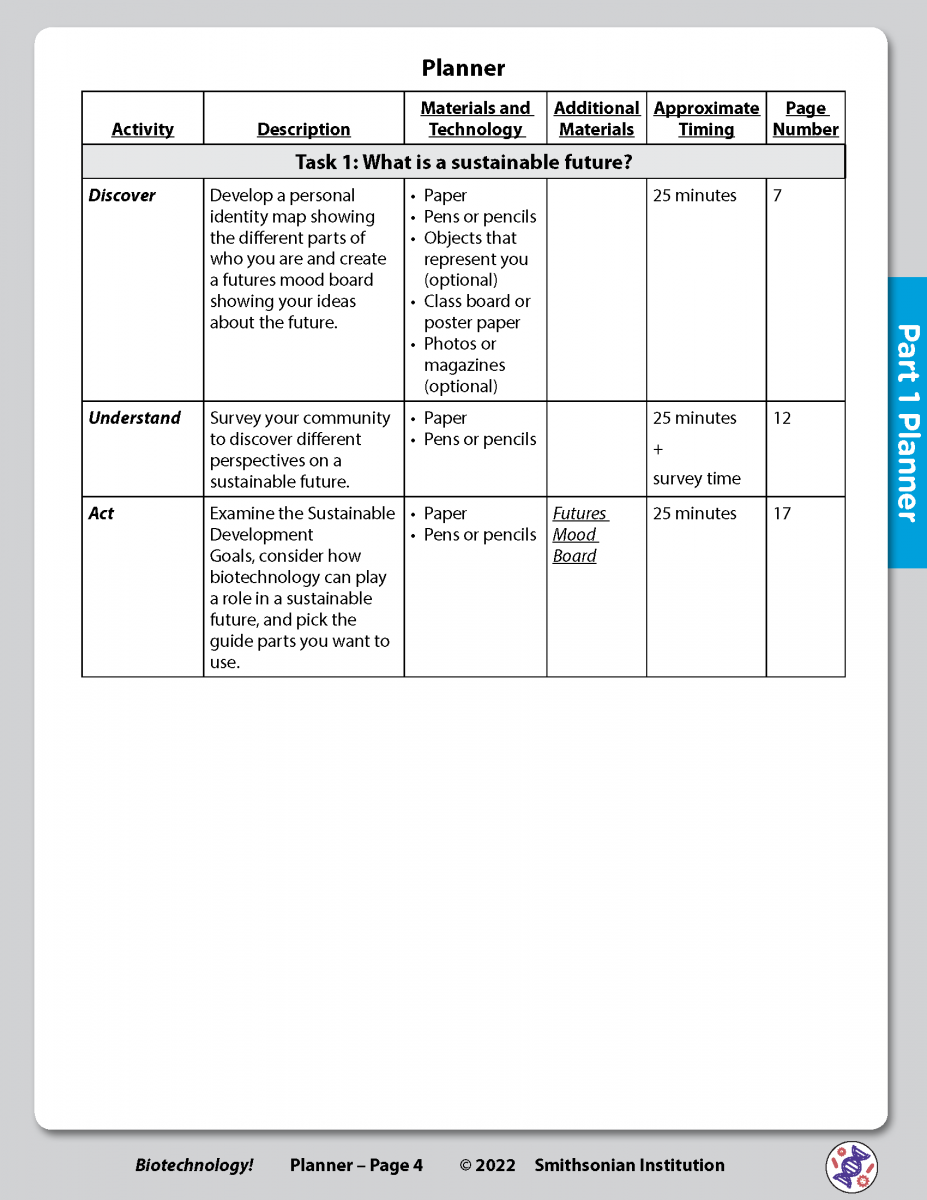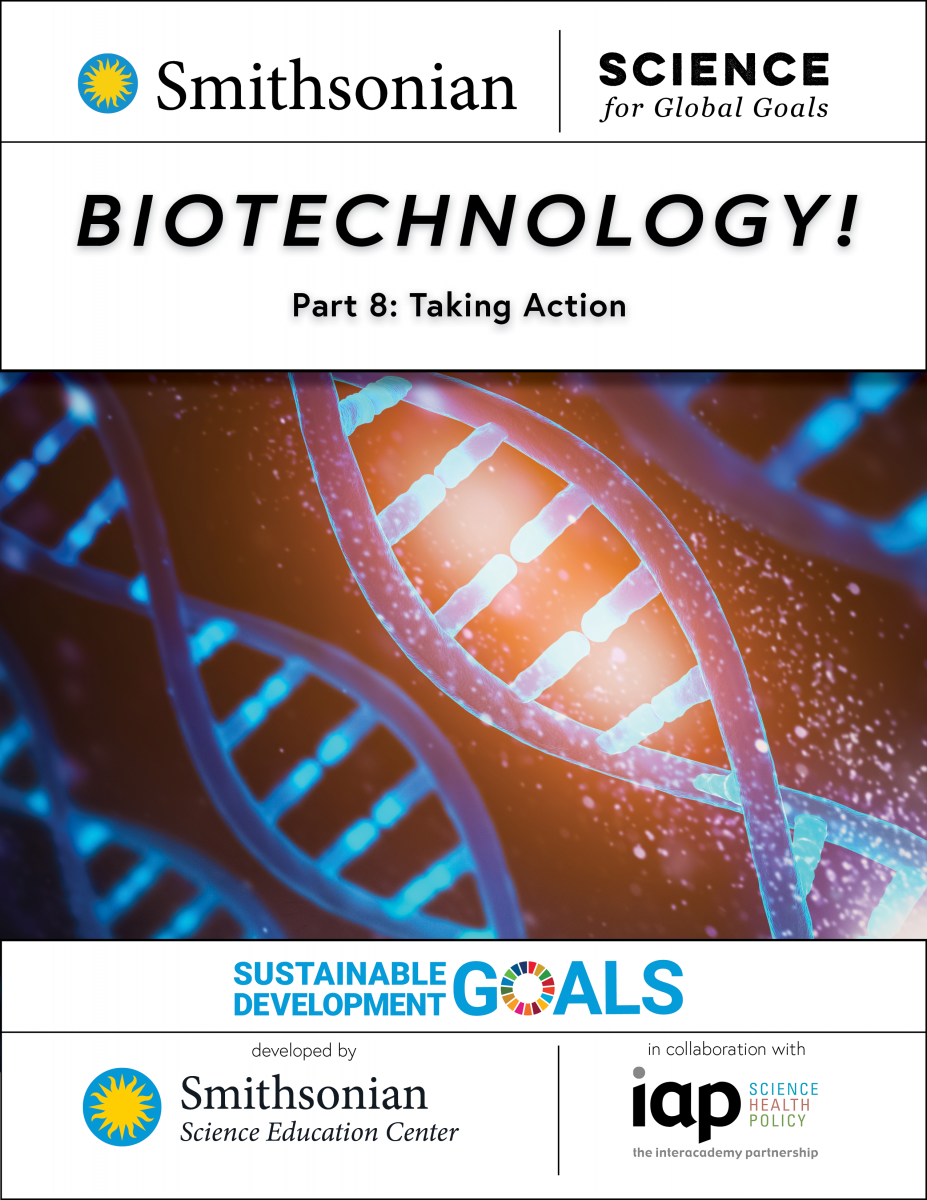Biotechnology! How can we ethically create a sustainable future using biotechnology?
Biotechnology! How can we ethically create a sustainable future using biotechnology?
Biotechnology! is a freely available community research guide developed by the Smithsonian Science Education Center (SSEC) in partnership with the InterAcademy Partnership as part of the Smithsonian Science for Global Goals project. These Smithsonian Science for Global Goals community research guides use the United Nations Sustainable Development Goals (SDGs) as a framework to focus on sustainable actions that are defined and implemented by students.
Biotechnology! is the new community research guide from the Smithsonian Science for Global Goals project for students aged 11 to 18. In the guide, young people explore the question “How can we ethically create a sustainable future using biotechnology?” They learn more about the potential of biotechnology while considering best way to navigate risks and concerns. While using the guide young people will become action researchers to identify and help solve problems in their community. They work through topics in biotechnology such as food systems, materials, human health, genetic data, the environment, and security. Along the way, young people are introduced to a wide variety of perspectives, develop research skills, and learn from real scientists from around the globe. After discovering their own knowledge and feelings about their communities, young people understand the different aspects of biotechnology through scientific and social scientific investigations. Then they use what they know and have learned to decide and implement actions to make their communities better.
Visit the StoryMap for additional resources.
Visit the Biotechnology! STORYMAP
Help us measure impact! By providing us with this basic information, you are ensuring that we can document the reach of the Biotechnology module and helping the Smithsonian Science Education Center to understand how to best support educators and parents as they undertake this module with their learners.
Click below to download the PDF files for each part of the community research guide. Follow the instructions in the research guide for each task.

DOWNLOAD Biotechnology! GETTING STARTED

DOWNLOAD Biotechnology! PLANNER


DOWNLOAD Biotechnology! PART 1
Task 1: What is a sustainable future? In this task young people will develop a personal identity map, survey their community, and examine the Sustainable Development Goals.
Task 2: How can biotechnology help create a sustainable future? In this task young people will explore what biotechnology is, investigate DNA, and consider different perspectives on using biotechnology.

DOWNLOAD Biotechnology! PART 2
Task 1: Should we use biotechnology to change the food we eat? In this task young people will analyze food systems, investigate genetic modifications, and explore hopes and concerns about GMOs.
Task 2: How can biotechnology help food systems contribute to a more sustainable future? In this task young people will model farmable land, explore how biotechnology restores and creates farmable land, and communicate ideas about farming techniques.

DOWNLOAD Biotechnology! PART 3
Task 1: How can biotechnology change the materials we use? In this task young people will explore material sustainability, make their own bioplastic, and consider impact of innovative materials.
Task 2: Can we create the materials we need using cells and biotechnology? In this task young people will investigate new materials including 3D bioprinting and think about ethical concerns to create materials.

DOWNLOAD Biotechnology! PART 4
Task 1: How can we diagnose diseases using biotechnology? In this task young people will explore what they know about diagnosing disease, identify genetic variants of diseases, and take on the role of genetic counselor.
Task 2: How can we fix genetic diseases using biotechnology? In this task young people will explore stages of diagnosis and gene therapy, model gene therapy options, and develop a communication plan about gene therapy.

DOWNLOAD Biotechnology! PART 5
Task 1: How should we use and protect genetic data? In this task young people will learn about genetic data, consider concerns about genetic data uses, and analyze perspectives on ownership and use of genetic data.
Task 2: How can environmental genetic data help identify and solve problems? In this task young people learn about eDNA and develop ideas about ethical considerations on the use of genetic data.

DOWNLOAD Biotechnology! PART 6
Task 1: How can biotechnology make our communities cleaner? In this task young people will observe pollution in their community, create a model of pollution problems. and consider perspectives on address pollution problems.
Task 2: How can biotechnology help restore biodiversity to ecosystems? In this task young people will model genetic diversity, investigate biotechnology's potential to restore biodiversity, and create rules about the use of biotechnology to encourage conservation.

DOWNLOAD Biotechnology! PART 7
Task 1: How can biotechnology help with security? In this task young people will explore biometrics, model facial recognition, and draft rules for when and how biometrics should be used.
Task 2: What are the threats to security presented by biotechnology? In this task young people will explore outcomes of bio-threat scenarios, investigate bio-threat vulnerabilities, and share information about bio-threats.

DOWNLOAD Biotechnology! PART 8
Task 1: How will I help create a sustainable world using biotechnology? In this task young people will decide what action to take and implement their action plans.





Kit Tips & Tricks